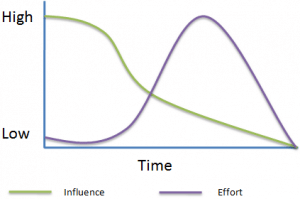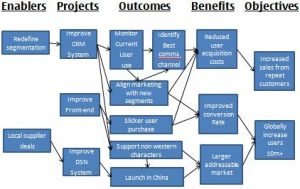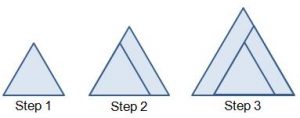I’ve just finished reading an excellent book by Eric Ries called The Lean Startup. You may be wondering already what running a startup has to do with program management? If you read on you will discover they actually have much in common…
Ries defines a startup as follows: “A startup is a human institution designed to create a new product or service under conditions of extreme uncertainty”. As the speed of technological change continues to increase, most programs operate under conditions of extreme uncertainty, and so using the above definition it is possible to consider programs as startups.
Think Big. Start Small.
At the heart of lean startup is the build-measure-learn feedback look.

The key to lean startup is to loop through a complete cycle of the build-measure-learn loop as quickly as possible, and then use your learning to determine how to proceed. To get through this cycle as quickly as is possible, lean startup introduces the concept of a Minimal Viable Product (MVP), which is the minimum product you can put in front of real customers in order to learn something. NB: when I refer to learning something I am primarily referring to learning something about the business model rather than the product, which is what differentiates lean startup from Agile development.
Book Summary
Note, we now have a detailed summary of this book available which goes into much more detail on the whole Lean Startup model.
Those seasoned program managers out there reading this will probably remember programs they’ve run where the business case looked great, the market research looked great, and even potential customers said they wanted the product, only to find when the product launched that it wasn’t a success in the market as predicted. I’m sure there are lots of you out there! I’ll admit that I’m one.
This is exactly the type of issue lean startup can help us address by forcing us to obtain feedback from real customers as early as possible in the program, even as we work towards our overall large program goals. The lean startup approach has even been applied within large scale government programs.
There is a great example of this in the book, whereby the Consumer Federal Protection Bureau (CFPB) has been established with a $500m budget to protect America citizens from loan sharks and credit card companies etc. The plan calls for a nationwide call-centre to field calls from concerned members of the public.
Despite its $500m budget, alongside the traditional program planning, the undertaking is being run on a micro scale to test the assumption in the plan that Americans will call the CFPB for help. That is a fair assumption but it is nevertheless an assumption of the plan and thus a risk. Because of this, one lean startup option the team considered was to setup a simple hotline number. With less than a days effort the hotline could have simple voice prompts to allow the customer to select which problem they are experiencing. Instead of having caseworkers on the end of the line a simple network based IVR automated response could be used to offer advice for that particular problem. This would be our minimal viable product.
This solution could be advertised within a very small area of a few blocks in a single city. The results would validate the initial assumtion and provide answers to interesting questions such as: Do people use the service? What are the most common financial problems people have? What time do people call? The answers to these questions could prove critical to shaping the overall program plan and making the bureau a success.
Loss of Brand
Another interesting topic within the book discusses how to deal with the perception that the company’s brand will be damaged if a minimal viable product is offered to its consumers. In this case lean startup recommends launching the MVP under a separate brand.
Conclusion
This is the best business book I have read in a while, and despite having the word startup in the title I believe it would make an excellent read for all program managers and senior managers in large organizations. I have written about Lean Program Management before but this book really fleshes out those ideas. You can find more information about lean startup by visiting Eric Ries’ Website.







